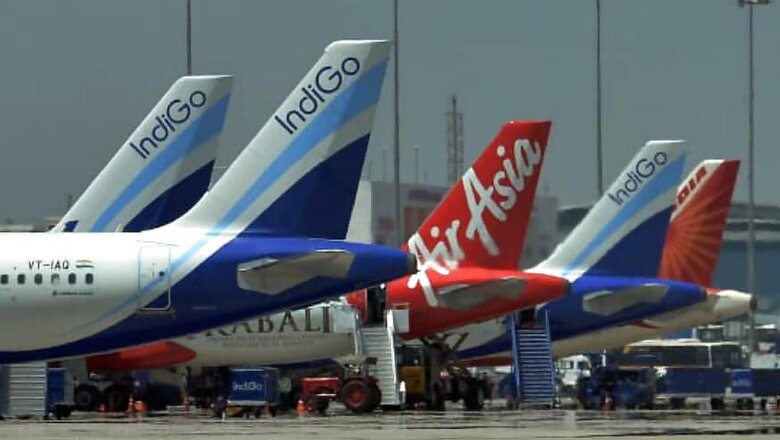
views
Just as the railways shaped modern India, cheap air tickets, driven by fierce competition between carriers, are changing the way Indians travel around their country.
They're also promising to take hundreds of millions more to the skies -- most of whom have never flown before.
But, ironically, cut-throat competition also means the very same airlines that unleashed this revolution may be among the last to enjoy its fruits.
Case in point: The recent collapse of debt-ridden Jet Airways -- one of India's biggest airlines. Despite operating in one of the world's fastest-growing aviation markets, on April 18 it announced it was indefinitely suspending all flights after it ran out of cash.
To better understand the current paradoxical state of India's aviation industry, we need to go back a few years.
In 2014, a relatively young Indian low-cost airline, IndiGo, made headlines by ordering 250 Airbus A320 aircraft in one go, a purchase worth a whopping $26.5 billion at catalog prices.
Coming on the heels of an earlier order for 100 aircraft of the same type, it was at the time the single largest aircraft order ever received by the European aircraft manufacturer.
While these figures may have seemed eye-catching back then, demand has caught up after four years of double-digit growth in the Indian commercial aviation industry, and
IndiGo is already changing up to bigger airplanes.
In late 2018, the carrier announced it was converting 125 aircraft from its A320 order to the A321neo type, a larger aircraft that's able to accommodate 220 passengers, instead of the 189 of the A320.
These aircraft mega-orders aren't one-offs, but reflect a wider trend.
In July 2016, budget carrier GoAir doubled the size of an earlier aircraft order of the new Airbus A320neo to 144. Spicejet has ordered 205 of Boeing's 737 MAX model.
Indian airlines have close to 1,000 outstanding aircraft orders in their books. To put this figure in context, there are currently nearly 700 operational airliners in India.
Two decades of wonder
So what does all this mean for travelers?
Basically, cheap domestic flights and more routes -- making it easier than ever to explore India, including destinations once considered too remote for a quick vacation.
Budget airlines now account for 70% of the domestic market and, according to the International Air Transport Organization (IATA), the average domestic fare in India now costs less than a third of what it did in 2005.
In the past 20 years, the Indian airline industry as a whole has multiplied the number of passengers it carries by eight.
Performance in the low-cost segment has been even more impressive: it has grown 27-fold since its beginnings (the first Indian low-cost carrier, the now gone Air Deccan, launched in 2003).
The end of the party is nowhere in sight.
"India has still the lowest air travel penetration rates among the top 20 air travel markets globally. It is low even compared to other emerging markets," explains Binit Somaia, South Asia director of CAPA, an aviation consultancy.
"If you look at domestic capacity, the number of annual available seats per capita, it is also well below other large economies; if India's is around 0.1, similar numbers for China and the US are 0.4 and 2.6 respectively. So there's room for way more growth."
Indeed, IATA expects the number of air journeys in India to more than treble over the next couple of decades, from the current 160 million to 520 million per year in 2037.
Even at their lowest end, IATA's traffic estimates project that India will become the third largest air travel market in the world (after the United States and China) within a generation.
Looking at passenger throughput, this may already have happened.
According to a report by the Airports Council International (ACI), in 2018 India became the world's third-largest aviation market, overtaking Japan.
Anand Stanley, president and managing director at Airbus India & South Asia, shares this optimism over the longer-term prospects of the Indian air travel market.
"The 8.1 billion train trips per year in India have the potential of getting converted into over 1 billion flying trips," he says.
"This represents enormous growth opportunities for the industry. We would expect the number of aircraft required to be close to 2,000 over the next 20 years."
Whether airlines are going to benefit as much as travellers and aircraft makers from this upcoming capacity increase is an entirely different matter, though.
Domestic market remains the focus
These newly established airlines have until now been limited to the domestic market. This is about to change as airlines reach the minimum fleet size threshold set by the Indian government to grant access to international routes.
But also of relevance is that the domestic market is larger and growing faster, so far.
But can India's infrastructure cope with all this growth?
Indian authorities have been busy building new airports to catch up: 34 of them have been inaugurated over the last 18 months as part of an ambitious plan that aims to build 100 new airports over a period of 15 years, 70 of these in greenfield locations.
Nevertheless, it's the international market that might be heading for a shakeup.




















Comments
0 comment